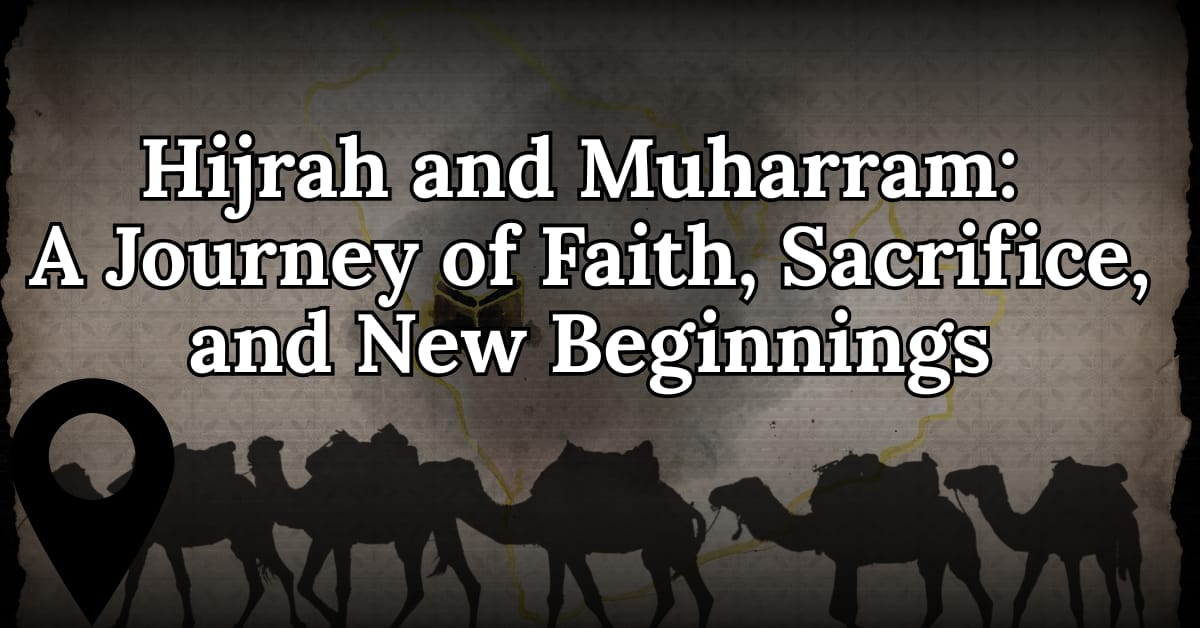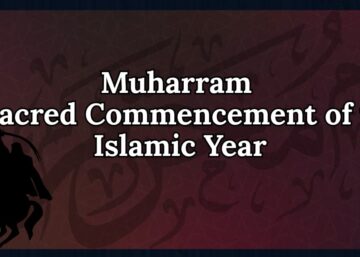Introduction
The beginning of the Islamic year marks not just the change of a calendar but a deep spiritual and historical milestone rooted in one of the most transformative events in Islamic history, the Hijrah. Muharram, the first month of the Islamic lunar calendar, carries a dual significance. It symbolizes the start of a new Islamic year and commemorates the migration (Hijrah) of Prophet Muhammad (PBUH) and his followers from Mecca to Medina. This monumental event in 622 CE wasn’t merely a relocation; it was the foundation of the first Islamic state and a pivotal turning point that shaped the future of the Muslim community.
The Islamic New Year begins with contemplation rather than celebration. Unlike the fanfare that marks the New Year in other cultures, the Islamic New Year invites introspection, spiritual renewal, and a recommitment to the principles of faith. Muharram sets the tone for this inward journey, as it is one of the four sacred months ordained by Allah, during which warfare is prohibited, and devotion is encouraged.
The Hijrah is far more than a historical memory; it’s a living symbol of sacrifice, struggle, and the unwavering pursuit of truth. Understanding this moment and its place in Islamic tradition helps believers connect deeply with their history and find meaning in their spiritual journeys today.
Understanding the Islamic Calendar
The Islamic calendar, known as the Hijri calendar, is a purely lunar calendar consisting of 12 months or about 354 or 355 days. This makes it shorter than the Gregorian calendar by about 10 to 11 days each year, which is why Islamic months shift across the seasons over time. The calendar begins with the month of Muharram and concludes with Dhul-Hijjah.
The calendar’s origin is directly tied to the Hijrah. In the 17th year of Hijrah (638 CE), Caliph Umar bin Khattab officially adopted the event of the Prophet’s migration as the starting point of the Islamic era. Unlike other civilizations that marked calendars by the reigns of kings or significant battles, Islam chose a moment of sacrifice and spiritual determination (the Hijrah).
Muharram, being the first month, holds particular importance. It’s not just the beginning of a new time cycle but a sacred phase meant for deeper reflection. The months in the Islamic calendar are not merely chronological but are deeply spiritual and thematic. The Hijri calendar serves not only administrative or historical purposes but also offers a rhythm of life centered on spirituality and community.
The choice to start the Islamic year with Muharram and align it with the Hijrah teaches us a profound lesson: true progress and transformation begin not with ease or victory but with sincere struggle and a heartfelt decision to change for the better.
The Sacred Month of Muharram
Muharram is more than just the first month of the Islamic calendar; it is one of the four sacred months mentioned in the Quran (Surah At-Tawbah, 9:36). These months are considered spiritually elevated, and Muslims are encouraged to increase their acts of worship, abstain from sin, and strive for personal growth. Muharram is often referred to as “Shahrullah al-Muharram” or “The Month of Allah,” indicating its unique sanctity.
The Prophet Muhammad (PBUH) emphasized the importance of Muharram in various Hadith. Among the most notable traditions is the encouragement to fast, particularly on the 10th day of Muharram known as Ashura. Fasting on this day is said to expiate the sins of the previous year. This day also commemorates significant historical events, including the liberation of Prophet Musa (Moses) and his people from Pharaoh’s tyranny.
What makes Muharram particularly special is its atmosphere of solemnity and introspection. Unlike other Islamic festivals that might be more festive, Muharram is a time of quiet remembrance. It invites Muslims to reflect on their lives, re-evaluate their priorities, and recommit to the values of justice, faith, and perseverance.
The month also holds special importance for the Shia Muslim community due to the martyrdom of Imam Hussain (R.A) at the Battle of Karbala. This event, though occurring decades after the Hijrah, deepens the month’s association with sacrifice and standing against oppression.
Ultimately, Muharram serves as a powerful reminder that time itself is a divine gift, and its renewal offers us a chance to renew our spiritual journeys.
What is the Hijrah?
The term “Hijrah” literally means migration or emigration. In the Islamic context, it refers to the migration of Prophet Muhammad (PBUH) and his followers from Mecca to Yathrib, later known as Medina. This wasn’t just a strategic move; it was a divine command and a necessary step to preserve the emerging Muslim community facing intense persecution.
Before the Hijrah, Muslims in Mecca endured years of oppression, ridicule, and economic sanctions. Despite these trials, the Prophet and his followers remained steadfast. When the situation became unbearable and plots to assassinate the Prophet Muhammad (PBUH) intensified, the command came from Allah to migrate. This migration wasn’t merely about changing physical location; it symbolized a break from tyranny and a new beginning rooted in faith and brotherhood.
The Hijrah also marked a shift from passive endurance to active establishment of a community based on justice, compassion, and divine law. It was during this time that Islam transitioned from a personal faith to a societal framework. Medina welcomed the Prophet Muhammad (PBUH) and his followers not just as refugees, but as leaders. The people of Medina (the Ansar) pledged their support, and in return, the Prophet Muhammad (PBUH) brought unity between various tribes, fostering a peaceful, diverse community.
The Hijrah is therefore not just a historical event; it’s a spiritual metaphor. It teaches Muslims that sometimes; to grow and fulfil divine purpose, one must leave behind comfort, confront trials, and make courageous decisions in the face of uncertainty.
Why Did the Prophet Migrate?
The decision to migrate was not made lightly. Prophet Muhammad (PBUH) spent over a decade in Mecca preaching the message of Islam. Despite his impeccable character and the moral clarity of his message, he and his followers were met with severe hostility from the Quraish tribe, the dominant ruling tribe in Mecca. The Muslims faced physical abuse, economic boycotts, social isolation, and even threats of death.
The Quraish were threatened by Islam’s message of monotheism and equality, which challenged their socio-economic structure and tribal supremacy. Converts to Islam often lost their wealth, status, and family ties. The Prophet Muhammad (PBUH) himself endured immense personal hardship, including the death of his beloved wife Hazrat Khadijah (R.A) and his uncle Abu Talib, who had been his protector.
When the Prophet approached other tribes for protection and migration, many refused. But when the people of Yathrib (later Madinah) invited Him and promised protection, the tide began to turn. They were already familiar with the idea of monotheism due to Jewish tribes in the area, and were suffering from tribal conflict. The Prophet’s (PBUH) leadership was seen as a solution to their disunity.
The migration to Madinah was an act of divine wisdom and strategic brilliance. It allowed Islam to flourish in a supportive environment where it could be practiced freely. The Prophet Muhammad (PBUH) established a constitution that granted religious freedom to all citizens, including Jews and pagans, setting a model for coexistence.
By choosing to migrate rather than retaliate, the Prophet Muhammad (PBUH) demonstrated the importance of patience, strategic planning, and reliance on Allah. The Hijrah teaches us that true leadership sometimes means walking away from confrontation in pursuit of a greater goal.
The Journey from Mecca to Madinah
The Hijrah wasn’t just a historical migration; it was a risky journey filled with intense risk and remarkable faith. When the Prophet Muhammad (PBUH) received divine instruction to migrate, He methodically planned the route to avoid detection. The Quraish had plotted to kill Him, and a bounty was placed on his Head. Yet, through divine protection and careful strategy, He managed to escape with His close companion, Hazrat Abu Bakr Siddique (R.A).
The journey covered approximately 320 kilometres through harsh desert terrain. Instead of taking the usual northbound route to Madinah, the Prophet Muhammad (PBUH) first travelled south to the cave of Thawr, where he and Hazrat Abu Bakr Siddique (R.A) hid for three days to avoid pursuit. It was in this cave that a spider famously spun its web across the entrance, and a pigeon laid eggs nearby, signs that led the Quraishi trackers to believe no one was inside.
From there, they took a less-travelled route through the coastal plains, guided by a non-Muslim tracker named Abdullah bin Uraiqat. This decision highlights the Prophet Muhammad’s (PBUH) rational approach. He was guided by divine revelation but also took practical steps to ensure safety and success.
The Prophet Muhammad (PBUH) and Hazrat Abu Bakr Siddique (R.A) faced multiple dangers, including chasers like Suraqa bin Malik, who was later inspired by the Prophet’s (PBUH) poise and promise of future glory to abandon his mission and eventually embrace Islam.
After days of travel, the Prophet Muhammad (PBUH) reached Quba, a small settlement near Madinah, where He stayed for a few days and established the first mosque of Islam, Masjid Quba. This mosque still stands today as a symbol of the beginning of a new phase for the Muslim Ummah.
The journey to Madinah wasn’t just a relocation; it was a foundational act of faith, leadership, and divine guidance. It marks the beginning of a society based not on tribal affiliations but on shared belief, justice, and spiritual unity.
The Establishment of the Islamic State
When the Prophet Muhammad (PBUH) entered Madinah, the city was eager to receive Him. The migration marked the first time that Muslims had the freedom to practice their religion publicly without fear. But it wasn’t just about freedom, it was about forming a cohesive society based on divine principles.
One of the Prophet Muhammad’s (PBUH) first actions was to build Masjid-e-Nabawi, the Prophet’s Mosque, which would become the spiritual and social hub of the community. This was followed by the drafting of the Constitution of Madinah, an unprecedented document for its time. It laid the groundwork for a multi-religious society, recognizing the rights of Muslims, Jews, and other tribes to coexist peacefully. It established rules for mutual defense, conflict resolution, and community responsibility.
The Prophet united the Aus and Khazraj tribes, which had been at odds for generations. He also established bonds of brotherhood (Mu’akhah) between the emigrants from Mecca (Muhajirun) and the residents of Madinah (Ansar), creating economic and emotional support systems.
Economically, the Prophet Muhammad (PBUH) introduced fair trade practices, zakat (almsgiving), and ethical business conduct. Socially, he advocated for the protection of the poor, women, orphans, and slaves. Spiritually, the call to prayer was established, and the rhythm of daily life was centered on devotion to God.
Madinah quickly became not just a refuge but a thriving example of a balanced Islamic society. It showed the world that a faith-based community could be just, peaceful, and inclusive. The Hijrah wasn’t the end of the journey; it was the beginning of a model civilization grounded in Tawheed (monotheism), justice, and compassion.
Hijrah: A Turning Point in Islamic History
The Hijrah is more than a migration; it’s a monumental shift that altered the course of Islamic and world history. Before the Hijrah, Muslims were a marginalized group surviving under hostile conditions in Mecca. After the Hijrah, they became an empowered community with the capacity to shape their destiny.
The event marks the beginning of Islam as a socio-political force. Madinah became the heart of the Islamic world, from where the Prophet Muhammad (PBUH) led battles, established treaties, and spread the message of Islam far and wide. The Hijrah also enabled the community to develop economically, culturally, and intellectually in an environment of security and cooperation.
Historically, the Hijrah represents the first instance in recorded history where a religion founded by a single Man not only survived oppression but flourished into a civilization within a single generation. It also introduced a moral and legal framework that would influence laws, ethics, and governance in many cultures across centuries.
Spiritually, the Hijrah serves as a metaphor for personal transformation. Every believer is called to make their form of Hijrah from darkness to light, from sin to repentance, from selfishness to service. The Prophet Muhammad’s (PBUH) journey is a living example of persistence, trust in God, and the power of faith to change the world.
The turning point wasn’t just political, it was deeply spiritual. It showed that even in adversity, believers could rise, organize, and create a legacy grounded in divine values.
The Beginning of the Islamic Calendar
The Islamic calendar, or Hijri calendar, begins not with the Prophet Muhammad’s (PBUH) birth or his first revelation but with the Hijrah, an intentional choice that speaks volumes. This decision was formalized during the caliphate of Hazrat Umar bin Khattab (R.A), who consulted with the Prophet’s companions on what event best symbolized the dawn of the Islamic era. The consensus was clear: the Hijrah was the moment when the Muslim community transitioned from oppression to sovereignty.
Thus, the first year of the Islamic calendar corresponds to 622 CE in the Gregorian calendar. This wasn’t simply a way to mark time; it was a spiritual and ideological declaration. It aligned the measurement of time with a foundational act of faith and sacrifice.
The Hijri calendar is lunar, meaning each month begins with the sighting of the new moon. This has both practical and spiritual implications, reminding Muslims of their connection to the natural world and the divine order.
The choice of Hijrah as the anchor of the Islamic calendar is profound. It says that history doesn’t begin with triumph or conquest; it begins with commitment, migration, and the readiness to sacrifice for one’s beliefs. It reminds Muslims annually, every Muharram, of the values on which their faith was built: devotion, community, sacrifice, and trust in Allah.
Lessons from the Hijrah
The Hijrah is full of timeless lessons that go far beyond its historical context. At its heart, it is a story of courage, sacrifice, and divine trust. The Prophet Muhammad (PBUH) left behind His birthplace, His home, and everything familiar, not for personal gain, but for the preservation of faith and the establishment of justice.
One of the most powerful lessons from the Hijrah is the concept of Tawakkul, complete reliance on Allah. Even with all the strategic planning, the Prophet Muhammad’s (PBUH) success ultimately depended on divine protection. His calm in the face of danger, His faith during uncertainty, and His hope amidst hostility are qualities every believer can learn from.
Another lesson is the value of community. The Muhajirun left everything behind, but the Ansar opened their hearts and homes to them, exemplifying the true spirit of brotherhood and selflessness. This mutual support was key to building a resilient and successful society.
The Hijrah also teaches the importance of action. While faith is internal, it must be expressed through decisive steps. The Prophet Muhammad (PBUH) didn’t wait passively; he took action with full conviction, showing that spiritual commitment requires physical effort.
In today’s world, the Hijrah can inspire personal transformation. Whether it’s leaving behind bad habits, toxic environments, or simply recommitting to one’s faith, every believer is called to make their own Hijrah to migrate toward Allah in both heart and deed.
Muharram as a Month of Reflection
Muharram is not just the first month of the Islamic calendar; it’s a time filled with spiritual depth and reflection. Being one of the four sacred months mentioned in the Quran, Muharram offers a unique opportunity for believers to step back, reassess their lives, and reconnect with Allah. It’s a season not of celebration, but of solemn remembrance and renewal.
Fasting during Muharram, especially on the 10th day known as the Day of Ashura, is highly recommended. The Prophet Muhammad (PBUH) said, “Fasting the day of Ashura, I hope Allah will expiate thereby for the year that came before it” (Sahih Muslim). This shows how Allah, in His mercy, provides opportunities for believers to cleanse their past sins and start anew.
Beyond fasting, believers are encouraged to increase in acts of worship such as prayer, reading the Quran, giving charity, and seeking forgiveness. It’s a time to revisit one’s intentions, set spiritual goals for the New Year, and let go of past grudges or regrets.
For many Muslims, Muharram also becomes a period of education and remembrance. It’s a time when stories from Islamic history, especially the Hijrah and the sacrifice of Hazrat Imam Hussain (R.A), are shared and reflected upon. These narratives highlight themes of justice, truth, resilience, and unwavering faith, all qualities every believer should aspire to.
Reflection during Muharram is both personal and communal. Families gather to teach and remember, mosques hold educational events, and communities engage in collective prayer and supplication. It’s a reminder that our lives should be guided not just by routine but by purpose, and that purpose should always lead us closer to Allah.
Commemoration and Contemplation
Muharram holds deep emotional and spiritual significance for both Sunni and Shia Muslims, albeit in different ways. While all Muslims honour the Hijrah and the sanctity of the month, Muharram also encompasses the sorrowful remembrance of the martyrdom of Hazrat Imam Hussain (R.A), the beloved grandson of the Prophet Muhammad (PBUH), at the Battle of Karbala.
For the Shia community, the first ten days of Muharram, especially Ashura, are days of mourning. The tragedy of Karbala in 680 CE symbolizes a fight against tyranny and the ultimate sacrifice for truth. The story of how Hazrat Imam Hussain (R.A) and his small group of supporters faced the massive army of Yazid, refusing to give allegiance to a corrupt ruler, is remembered with deep reverence and sorrow.
The Sunni tradition, while also acknowledging the tragedy of Karbala, emphasizes fasting and spiritual renewal based on the Prophet’s (PBUH) practice. The Prophet Muhammad (PBUH) fasted on Ashura to commemorate the victory of Prophet Musa (Moses) and the Israelites over Pharaoh’s oppression. When he learned that Jews also observed this fast, he said, “If I remain till the next year, I will fast the 9th too” (Sahih Muslim), hence the practice of fasting on the 9th and 10th of Muharram.
This dual aspect of Muharram, celebrating divine victories and mourning noble sacrifices, makes it a profound time for both contemplation and commemoration. It teaches that Islam is not just a religion of rituals but a faith rooted in moral courage, standing for justice, and remembering the cost of truth.
Regardless of sect, the month reminds all Muslims to be introspective, value their beliefs, and renew their commitment to live with integrity, compassion, and resolve.
Renewal of Faith and Intentions
One of the most powerful elements of Muharram and the Islamic New Year is the opportunity it offers for spiritual renewal. Just like people make resolutions in the Gregorian New Year, the beginning of the Hijri year calls Muslims to reassess their relationship with Allah and realign their life’s direction with their faith.
Renewing faith (tajdeed al-iman) involves more than just spiritual feelings; it requires action. It means recommitting to the pillars of Islam, improving one’s prayer, being mindful in worship, and striving to obey Allah in all aspects of life. Muharram becomes the ideal starting point for this because it’s linked to the Hijrah, a literal and symbolic journey from darkness to light.
Setting new spiritual goals can include memorizing more Quran, increasing dhikr (remembrance), learning more about the Prophet Muhammad’s (PBUH) life, or serving the community. Even small steps, when taken consistently, can lead to major transformations.
This month also encourages introspection. Where am I now in my faith journey? What am I struggling with? What am I thankful for? What needs to change? These are the questions every believer should ask. Hijrah was about leaving behind what holds us back from Allah, be it fear, sin, bad habits, or toxic environments.
Renewing intentions (niyyah) is equally vital. Islam teaches that every action is judged by its intention. A new year is a fresh slate to purify our goals, not for ego, fame, or worldly gains, but solely for the sake of Allah.
In this sacred month, Muslims are called to start again, not just in terms of time but in terms of purpose. The New Year is not just a change of date; it’s a call to change ourselves for the better, inspired by the timeless legacy of the Hijrah.
Hijrah and Modern-Day Migration
The concept of Hijrah isn’t confined to history. In today’s world, many people are forced to migrate due to war, oppression, poverty, or the search for better opportunities. The story of Prophet Muhammad (PBUH) and his companions serves as both a blueprint and a beacon for those undergoing similar hardships.
Like the Prophet’s (PBUH) Hijrah, modern migration is often driven by the hope for freedom, safety, and dignity. Muslims fleeing conflict zones today can find solace in knowing that the beloved Prophet Muhammad ﷺ was also once a migrant seeking refuge, building anew, and relying wholly on Allah.
But Hijrah isn’t just about physical migration; it’s about spiritual transformation. Every believer must undergo their own internal Hijrah, migrating from heedlessness to awareness, from sin to obedience, from apathy to compassion. This kind of migration is accessible to everyone, regardless of location or circumstance.
The lessons of Hijrah are especially relevant in a globalized world where identity, faith, and values are constantly challenged. It calls Muslims to uphold their faith no matter where they live, to build communities based on justice and compassion, and to contribute positively to society.
Moreover, the Hijrah reminds us to support migrants and refugees, just as the Ansar supported the Muhajirun. Compassion, hospitality, and solidarity are not optional; they are core Islamic values demonstrated at the very birth of the Muslim Ummah.
Hijrah, therefore, is not a distant memory; it’s a living example for all of us to reflect, relocate our priorities, and realign our lives with divine purpose.
Conclusion
The Islamic New Year, beginning with the sacred month of Muharram and grounded in the profound event of the Hijrah, is a time not for fireworks but for faith, not for noise but for nourishment of the soul. The migration of the Prophet Muhammad (PBUH) was a turning point that laid the foundation for a global civilization and offered a model of spiritual resilience, moral clarity, and community-building.
Every year, as the moon heralds the arrival of Muharram, Muslims are invited to revisit that journey not just with the mind, but with the heart. It’s a time to recommit to the path of righteousness, to make our own personal Hijrah, and to strive for the same values that defined the early Muslim community: truth, justice, sacrifice, and trust in Allah.
In a world full of distractions and challenges, Muharram and the Hijrah serve as a compass pointing us back to our origins and our ultimate purpose. Let us honour this beginning not just with words, but with action through prayer, reflection, learning, and sincere devotion.



